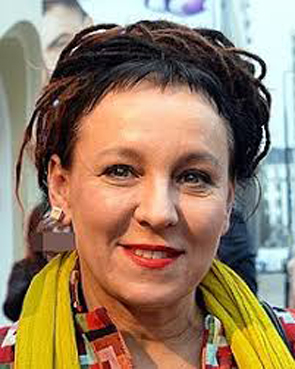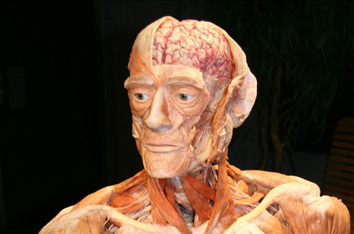Novels like Olga Tokarczuk’s Flights, if nothing else, return the reader to other texts, reminding us that intertextuality is a part of the richness and meaning of many written works. The English version’s title conjures thoughts of travel, and indeed, Tokarczuk’s opening chapters are reminiscent of De Botton’s Art of Travel in its philosophical predilections. Travel is the subject of much of the book, whether it be the narrator – a close surrogate of Tokarczuk one feels – whose meditations on the meaning of travel as she moves through airports and travels in planes, synthesise disparate stories and facts throughout, or characters who either travel or, to assume the other meaning of the English word, flee, in their various narratives. Some literary references are specific. Tokurczuk’s narrator claims Moby Dick to be one of only two books to which she has remained faithful
, the other being Benedyct Chmielowski’s travelogue which she quotes at length: it is reminiscent of old maps whereupon at the edges the cartographer would write here be monsters
. In fact, Tokarczuk’s book is rich in references to old paintings and art exhibits, scientific treatises, novels, poetry, religious iconography and, yes, maps (there are twelve reproduced throughout the text). It’s a real cornucopia with no less than a dozen main stories that are spread across the novel’s length, most having no obvious immediate narrative connection.
Is the book a mess? It could well be thought so, depending upon its reader. Certainly, Tokarczuk is aware of its possible reception:
Am I doing the right thing by telling stories? Wouldn’t it be better to fasten the mind with a clip, tighten the reins and express myself not be means of stories and histories, but with the simplicity of a lecture, where in sentence after sentence a single thought gets clarified, and then others are tacked onto it in the succeeding paragraphs? I could use quotes and footnotes, I could in the order of points or chapter reap the consequences of demonstrating step by step what I mean; I would verify an aforementioned hypothesis and ultimately be able to carry off my arguments like sheets after a wedding night, in view of the public . . .
But Tokarczuk’s doubts are a rhetorical flourish, at most. She knows exactly what she is doing in the seeming randomness, the chaotic (to use a word she employs to refer to the perception of time by travellers) sense created by the various stories and factoids she offers:
Due to the earth’s rotation, throwing something westward will send it flying further than if it’s going east.
The average human body contains enough sulphur to kill a dog.
Read in isolation there is no connection between the two facts. But read in the context of the entire novel, Tokarczuk’s synaptic connections begin to make sense. In one of the dozen main stories an aging professor travels Greece with his wife, employed by a cruise company to offer lectures to its travellers. Already we remember Tokarczuk’s reticence about lecturing, but the professor does not offer hypotheses and footnotes, but an experience of the history and culture he knows so well; an educator, yes, but also an entertainer and an humanitarian.
If an hypothesis emerges from the novel it is only at the Tokarczuk’s taking on the role of a midwife
rather than the role of a professor, or the tender of a garden whose only merit is at best sowing seeds and later to fight tediously against weeds.
Key themes, stories and concepts gain significance within the text through repetition, but the reader is left to do much of the work to make the connections, like a mother giving birth aided by the midwife, to extend Tokarczuk’s own metaphor. Tokarczuk’s narrator tells us at the beginning that she is less interested in the well-travelled paths of travellers, but is more interested in curiosities and the bizarre: My weakness is for teratology and for freaks
. It’s an interest that draws her to a long meditation upon dead bodies. Like the hagiographic worship of saints’ relics of old, the traveller/reader is forced into a strange pilgrimage through the history and practices of the preservation of bodies for instance, and the modern-day practice of plastination, in which bodies can be preserved and displayed almost indefinitely. The shift from philosophical considerations about travel to the preservation of bodies seems bizarre, but connections begin to multiply. The story of Eryk, a whaler in the nineteenth century, returns us once again to Moby Dick, a book Eryk embraced in prison, not just as an entertainment but also for the idiosyncrasies of its language. Later, an arm preserved in fluid by Dr Blau, another story, is evidently the arm of Eryk, with its tattoo depicting a scene from Moby Dick. And Filip Verheyen, another anatomist, whose leg is amputated after an infection, preserves it and slowly dissects it over his lifetime. In a later story about Chopin’s heart, Graziella, who is tasked with returning the heart to Warsaw after the composer’s death, has herself a useless leg, injured beyond help when her carriage is overturned in a riot. Tokarczuk leaves the reader to make what connections they will, the text suggesting meaning through its own intertextual allusions.
What is evident is that Tokarczuk’s novel is not narcissistically clever, but somewhat political. In the story of Josephine Soliman, told through three letters she writes to Francis I of Austria, we experience Josephine’s despair as she tries to have her father’s corpse returned to her for burial. Her father, a black courtier, has been stuffed, preserved and put on display as part of the emperor’s case of curiosities. The story is exemplary of the Tokarczuk narrator’s antipathy towards science, herself once a psychology student taught the scientific method:
Here we were taught that the world could be described, and even explained, by means of simple answers to intelligent questions. That in its essence the world was inert and dead, governed by fairly simple laws that need to be explained and made public – if possible with the aid of diagrams. We were required to do experiments. To formulate hypotheses. To verify. We were inducted into the mysteries of statistics, taught to believe that equipped with such a tool we would be able to perfectly describe all the workings of the world – that ninety percent is more significant than five.
For Josephine Soliman, science has not ennobled her father but debased him and reduced him to a singularity; an object of science. It is the very antithesis of the idea of travel: that life and humanity exist in movement; that freedom exists in movement:
This is why tyrants of all stripes, infernal servants, have such deep-seated hatred for the nomads – this is why they persecute the Gypsies and the Jews, and why they force all free peoples to settle, assigning the addresses that serve as our sentences.
What they want is to create a frozen order, to falsify time’s passage . . .
Through travel the individual experiences chaotic time – the discombobulation of time zones and the unfamiliar – rather than the linear time of an ordered world. Stasis induces compliance. It’s an interesting thought given that Europe has suffered enormous turmoil over the political fallout over the issue of refugees in the past few years. The control of the body becomes an act of political oppression, even beyond death, it seems. At the same time, Science reduces rather than enervates understanding of the world.
Flights is not a novel that will please everyone. It demands some patience from the reader and some work to make sense of its various elements and narratives. But it is a novel that both entertains through its insights and its various stories, and will reward several readings; it is rich in things to think about. It provokes thought on philosophical, personal and political levels. Highly recommended.

 RSS Feed
RSS Feed Facebook
Facebook Instagram
Instagram YouTube
YouTube Subscribe to our Newsletter
Subscribe to our Newsletter






No one has commented yet. Be the first!